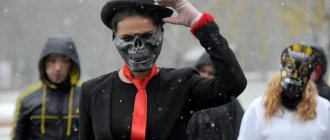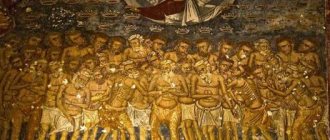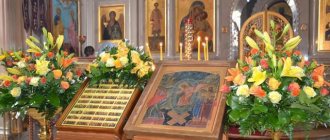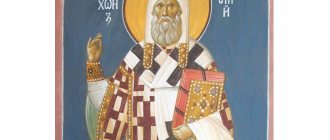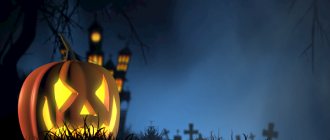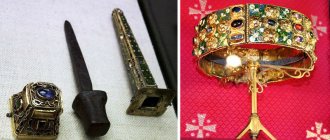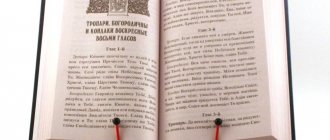Every year on October 31st, many countries around the world celebrate Halloween, also called Witch's night. This day is considered one of the most sinister holidays. Ghosts, vampires, zombies and other “dark” characters seem to come to life: in this way, people in disguise try to scare away real evil spirits. As the story of Halloween tells, on this night the gates to the other world open. To protect your home from otherworldly entities, you need a creepy outfit and a scary pumpkin face.
The origin of the holiday
Halloween has been celebrated for over 2000 years. Over a long period of time, the pagan holiday was transformed into a modern one, preserving ancient traditions and customs. Researchers believe that the history of Halloween begins with ancient Celtic culture.
About two thousand years ago, the population of the British Isles celebrated the pagan holiday Samhain . Translated, Samhain means “end of summer.” The event was dedicated to the arrival of winter and the beginning of the new year on November 1. On the eve, the Celts honored the memory of the dead, celebrated holidays (Day of the Dead and Harvest Day), lit huge bonfires and made sacrifices - livestock and crops. In Anglo-Saxon culture, the year was divided into two parts - dark and light. Samhain symbolized the end of summer and the beginning of winter. The event was strongly associated with the other world, mysticism and horror.
In the sixth century AD, Pope Boniface IV consecrated the Pantheon, the pagan “temple of all gods” built in Rome in the 2nd century AD. e. A Christian church arose on the site of the Pantheon. This event marks the origin of All Martyrs' Day. A century later, Pope Gregory III ascended to the Holy See. He canonized the new names, moved the holiday to November 1, and since then it has been called All Saints' Day.
At that time, the Romans were conducting a large-scale conquest of Europe. As a result, Christian culture penetrated the British Isles, Gaelic rituals mixed with Catholic traditions. Now the population of modern England, Scotland and Ireland also celebrates Halloween.
The correct name sounds like All-Hallows Eve , which translated means “the eve of All Hallows’ Day.” Later the name acquired a simpler form - Halloween. The holiday itself spread far beyond the borders of Rome and Britain - to other European countries, the USA, Canada, Japan, and Pacific island states.
Kindling the sacred fire
As mentioned, the fire ritual was central to Samhain. As on other holidays of the Wheel of the Year, the fire was kindled “clean” or “new” - from a spark or friction, and then spread to all houses. Before this, the fire was extinguished everywhere, and it was strictly forbidden to light it until the moment when the priests performed the ritual of lighting the sacred fire. Then, with the help of torches, the fire was carried throughout all the courtyards and the hearths were kindled, they went around the fields and villages with torchlight processions, thus protecting the possessions from evil spirits, witchcraft and everything harmful. The smoke from the ritual fire helped cleanse the home through fumigation, livestock were led through the smoke for cleansing and healing, and the ashes and coals were preserved as magical tools.
How to celebrate Halloween
In addition to the lighting of fires and sacrifices, the central element of Samhain was dressing up. People believed that a scary costume would protect them from ghosts and help them blend in with the crowd of evil spirits roaming the earth. With the advent of Christianity, the ancestors of modern Britons did not give up dressing up, but began to use other costumes - the outfits of saints, angels and demons.
In those days, treats were left on the doorsteps of houses as a ransom from the spirits and a call to bring a good harvest next year. This is associated with the emergence of the famous phrase “Treat or treat,” which in the original sounds like “Trick or treat.”
How Halloween, then called Samhain, used to be celebrated:
- They slaughtered some of the livestock and stored meat for the winter.
- The last harvest was completed.
- Cleansing fires were lit. People believed that this would help the deceased move from purgatory to heaven.
- They adhered to the ritual of a silent dinner, leaving a free place at the table for the deceased ancestor.
- Young people dressed up in costumes of evil spirits and the dead, made creepy masks that terrified their neighbors, and walked from house to house with lit lamps.
- The mummers knocked on doors and entertained the owners, receiving treats in return.
Previously, lamps were made not from pumpkins, but from turnips. A scary face was cut out of the vegetable and a lit candle was placed inside to scare away evil spirits.
That night they guessed about the betrothed, the number of children and the place of residence of the new family. Fortune telling was carried out on apple peels, fried nuts and egg whites. Later, the mystical beliefs of the Celts complemented Catholic rituals that carried a sacred meaning.
Food for Samhain
When talking about food at Samhain, it should be understood from two angles - on the one hand, it is holiday food, what was prepared for the feast and eaten by everyone. On the other hand, this is a special ritual food that was used in rituals and was perceived as a magical remedy (which could then be used throughout the year). Such food included special bread baked on coals from ritual fires; in other places it was whole grain flatbread. Such bread carried magical healing and protective properties; not only all family members, but also pets received a piece, and a certain part was presented as a gift to the gods, spirits and souls of the dead.
Traditions and legends associated with Halloween
The Celts believed that you could ward off evil spirits by bringing a sacred flame into your home and lighting a winter hearth. Part of this ritual has been preserved. Therefore, the history of Halloween in the 19th-20th centuries tells about a mandatory attribute of the celebration. It became a pumpkin in which a creepy human face was carved. Lighted candles were placed in the middle of the vegetable. This is how the Jack-o'-lantern was born.
According to an old legend, the name is associated with the story of an Irish farmer. Jack was a terrible drunk. But he managed to deceive the devil twice, for which he was punished. Jack's path to hell and heaven was closed, so the unfortunate farmer (or rather, his soul) was forced to forever wander through purgatory, making himself a lantern from a coal that was finally thrown by the devil.
According to another version, the story began a little differently. Jack was a merchant. One day he stopped by a bar and invited the devil to have a drink with him. When the time came to pay for the alcohol, Jack cheated and made Satan turn into a coin. Jack then placed the coin in his breast pocket next to the silver cross, and the Devil fell into the trap. After some time, the clever merchant freed Satan, making him promise not to bother Jack for a whole year, and in case of death not to take his soul to hell. The devil agreed, but Jack deceived him again.
He asked the demon to climb the apple tree, and while he was picking the fruits, he carved a cross on the tree trunk. Satan again fell for the cunning trick, and was forced to promise not to touch Jack for another 10 years. When the merchant died, God abandoned him and did not accept him into heaven because of his drunkenness and sinful life. The devil did not take Jack to hell, leaving him to wander in purgatory forever.
When Irish migrants came to America, they brought their traditions to the continent, including the celebration of Halloween. Jack-o'-lanterns were originally made from turnips, a crop that, according to legend, was grown by the doomed farmer. But in the USA the ritual was changed somewhat. Halloween lanterns were cut out of pumpkins, which were much easier to obtain.
Another ritual that is not mentioned much is the fishing of apples from the trough. The apple is a symbol of the goddess of fruit and abundance, Pomona, revered in the Roman Empire. That is why young boys and girls on the islands began to use the apple in fortune telling on Halloween.
No holiday is complete without food. At first it was distributed to mummers or left on the doorstep of the house. Now children dressed in the most incredible costumes are treated to sweets.
Halloween in Western culture
Halloween is most widely celebrated in Canada and the United States, where it was brought by European immigrants, primarily the Irish and the British. In the United States, preparations for the holiday begin long before October 31st. Already in mid-September, Americans begin to prepare decorations, costumes, and gifts for the celebration. However, in recent years, the format of the celebration has changed - Halloween is becoming more of a family holiday, the traditions of mischief and begging for sweets are becoming a thing of the past. However, the holiday still remains an important date on the calendar.
Halloween is also celebrated in other countries. For example, in Mexico the holiday is different from the American format. It is customary to celebrate the Feast of the Holy Death, to which Mexicans have a different attitude than we are accustomed to. It is customary to honor deceased ancestors; food and drinks are left for them. Also in Mexico, graves are decorated for this holiday, and songs are sung in honor of the dead. Despite the surroundings, the Holiday of Death is not gloomy, but rather cheerful.
In Germany, too, Halloween is celebrated, the attributes of the holiday are creepy decorations of houses and streets, garlands, scary costumes. Jack-o'-lanterns are as popular as they are in the US. The celebration is especially grandiose in the city of Darmstadt, where Frankenstein's castle is located. This attraction attracts more and more tourists every year.
In England, Halloween is widely celebrated, and the number of symbols, attributes and traditions of the celebration is greater than in American culture. Thus, in Britain, the tradition of carving heads from turnips (along with pumpkins) is still preserved. Numerous ancient castles and other places associated with something mystical are becoming popular these days. Fortune telling, spiritualism and other magical rituals are quite popular pastimes in England during Halloween.
It is worth noting the financial side of the celebration. Halloween for the United States is the first in a series of holidays, followed by Christmas, Hanukkah, Valentine's Day and other holidays. Americans are actively buying sweets before the holiday - in 2021, according to VOX estimates, $2.75 billion worth of sweets were sold during the week.
By some estimates, confectionery sales during the week before Halloween account for approximately 8% of sales for the year and 34% of sales for the season. In addition to sweets, it is customary to buy jewelry, costumes, and other holiday attributes. Therefore, Halloween is important not only as a cultural event, but also from an economic point of view.
In Western culture, Halloween is also reflected in art:
- cult film Halloween (1978) . The film had a major impact on the horror genre, the director received acclaim, and the film became a franchise;
- Roger Zelazny's novel A Night in Dreary October (1993), which received a Nebula Award nomination for best novel, is dedicated to Halloween
- Halloween is featured in Henry Selick and Tim Burton's The Nightmare Before Christmas (1993);
- Every season of The Simpsons has a Halloween episode (“Treehouse of Horror”) that parodies various works of art—movies, TV series, etc.
All Hallows' Eve today
The modern holiday of Halloween has long ceased to be frightening. Today it has almost completely lost its sacred and religious character. All Saints' Eve is celebrated in different countries of the world, turning this event into a slightly scary, but humorous holiday. Children especially like it.
The kids dress up in a variety of costumes, not necessarily creepy ones, and go from one house to another, begging for treats. They shout the same phrase: “Trick or treat!” Adults also do not refuse to take part in the fun celebration and treat this event with a fair amount of humor. Dressing up in costumes plays a central role. You can dress up as anyone - the scarier the merrier.
Witch image
Associated with an evil old woman with mystical powers. The ancient Celts honored the witch, who was one of the essences of the triune goddess of wisdom. But now the image of an elderly witch in a pointed hat necessarily comes with a bad reputation.
Vampire costumes
One of the most popular Halloween outfits. Vampires scare everyone because they are bloodthirsty and immortal. Their element is night, so All Hallows' Eve is a very appropriate holiday. The tradition of dressing up as vampires appeared relatively recently, and mummers most often dress in the costumes of the movie Count Dracula.
Ghost characters
Since Halloween is closely associated with the spirits of the dead, there are ghosts. Today you can find on sale any outfit for dressing up as ghostly entities. There are interesting options with bluish or greenish lighting. Seeing such horrors can actually scare you.
The zombie apocalypse
The Walking Dead is also present at the Halloween celebration. The image of zombies entered popular culture from popular films and TV series, and ideas for films came from the beliefs of African peoples. Primitive tribes believed that a person’s soul could be stolen from his body.
Werewolves in wolf's clothing
People turning into wolves in rather creepy costumes make Halloween even more frightening. These mystical characters appeared in Roman culture 2000 years ago. Asian folklore has its own legends about werewolves, but their role is played by foxes.
Now you can choose absolutely any image for the holiday - pirates, skeletons, spiders, griffins, fairies, princesses and even good wizards. The main condition is that it be scary and fun at the same time.
Modern celebration of Samhain
Preparation - cleaning
Samhain Day is a transitional time, and it is better to meet it without unnecessary “tails”, in purity.
Therefore, it is important to clean the house in advance - collect and throw away all the trash, wipe off the dust. Focus on the fact that along with the dust you are removing everything harmful from life, let this become a magical act. To cleanse your inner space, write down on a separate sheet what you want to get rid of in your life. Later this piece of paper can be burned. To wipe away dust, you can use water with sea salt dissolved in it and a couple of drops of essential oil - this is also an energy cleansing. Everything is wiped and washed down to the farthest corners, everything unnecessary from things to information media, books and papers is thrown away or distributed. Energy cleaning
Here you can carry out classic cleaning of the room using candles.
We have already described in our blog how this can be done. There is another option for cleaning with salt - when the salt is either scattered in the corners or placed there in cups and bowls with the words “Where it came from, there it goes” at night. In the morning, the salt should be heated in a frying pan to the maximum, and then taken away from the house and human presence, and poured out there, without being distracted by anyone or anything along the way. Remains of salt in the corners, if any, are swept to the threshold, collected, dissolved in water, and the floor is washed with this water. Next, you can use fumigation with herbs (for example, wormwood) along the perimeter of the house in a clockwise direction and ventilation. Fire of Samhain
Instead of a ritual fire, you can light candles, remembering deceased loved ones.
Fire is best ignited by spark or friction, like in the old days. A candle can be left on the altar and on the window to help spirits find a way out. Prepare flat cakes and invite the visiting spirits to the meal. Place some food on the altar. They set the table, placing a device for one of your loved ones who has left your life this year (or recently). If someone happens to be near your feast, they should be treated. It is good to have a meal in silence or with a calm sound accompaniment, without noise or dancing. Requests received at this time should be satisfied whenever possible. Meditation
Meditation on the night of Samhain can be associated with the past - with a review of some events of the past, oneself and one’s emotions in them. Let the events and images themselves emerge in your memory, just breathe calmly, letting go of the feelings and emotions associated with them. The themes of meditation can be death and transformation, variability. Samhain Colors:
- fiery;
- ginger;
- brown;
- black;
- yellow;
- the color of fire and a burning torch.
The Magic of Samhain
From the point of view of magical practices, the night of Samhain is one of the strongest nights of the year. The spirits and forces involved in magical rituals become accessible. This is a time that is flexible to change and is great for:
- purification magic;
- candle magic;
- mirror magical actions;
- protective practice;
- past life practices;
- clearing the path of obstacles;
- achieving peace and harmony;
- visualization;
- manti on cards and runes.
Schedules for Samhain
Tarot spread "The Raven" The layout is based on Edgar Allan Poe's poem "The Raven". The cards are laid out in the shape of a raven's beak. 12 ***************** * ************* 3 ******** 8 ********************** 4 *** ************ 5 ******** ******* 6 **************** 7 **** ********************
- Beloved Lenore - What influence does the past have on your life.
- Knock on the door - What you should pay attention to.
- The majestic raven is your deepest fear.
- Echoes from the darkness are the basis of your fears.
- The House of Haunted Horror – Why You Hold on to Your Fears.
- Ominous Bird of the Past - What you must understand and see.
- Shadows on the Floor - What You Refuse to See
- Raven croaked: “Never!” – How fears will affect your life if you don’t confront them.
Tarot spread "Pumpkin"
******1******* ****2*3*4**** **5*******7** ***6**9**8***
- Cut and remove the cover. What needs to be done first so that you can see yourself more clearly.
- Frozen pulp. What you need to work on until the end.
- Seeds. Your growth potential.
- Removable pulp. Obstacles on your way.
- Emptiness. Shadow inside. What you don't see in yourself.
- Thread. What you should pay attention to.
- Candle. Your inner light. Positive qualities. How to start shining.
- Replacing the cover. How the changes will affect you.
- Placement in a window. How the changes will be assessed from the outside.
Haunted House Tarot Spread
*****7***** ***5***6*** **3*****4** **1**8**2**
- The skeleton in the closet is a secret you try to keep.
- Rats in the basement are a secret that you can’t even admit to yourself.
- Black cat in the hallway - what makes you “let out its claws”?
- Pumpkin in the kitchen - what or who are you ready to “stick a knife into” and have a blast?
- Ghost in the bedroom - Who or what has taken over your thoughts.
- Spider in the bathroom - what makes you angry?
- Bats in the attic - what's driving you crazy?
- The front door is the way out of all this madness... or maybe the entrance?
Another layout for Samhain
This layout is dedicated to the traditional pagan / neo-pagan European holiday of the transition from autumn to winter, falling on November 1-2. This is a period of summing up past events and deeds, final choice and decision-making, farewell to what has become obsolete and preparation for the difficult period of winter. This is also the time of contact between the world of the living and the world of the dead, with another world... the idea of which has been preserved throughout Europe, from the Celtic Samhain and the Icelandic álvblót (the holiday of honoring the Ælvs on November 2) to the Slavic commemoration of grandfathers (November 2). *****3*****6*****7***** 1*********4**********9 **** *2*****5*****8*****
- The autumn harvest is fruits that you can take advantage of.
- Emergency stock - what should be put aside until spring.
- The Trials of Winter are challenges.
- The passage between worlds - new ways of action.
- Samhain Gifts are bonuses from a period or action.
- Meeting the unknown - what you have to face.
- What to say goodbye to...
- What to remember...
- Results.
We wish you a fruitful holiday and new days!
